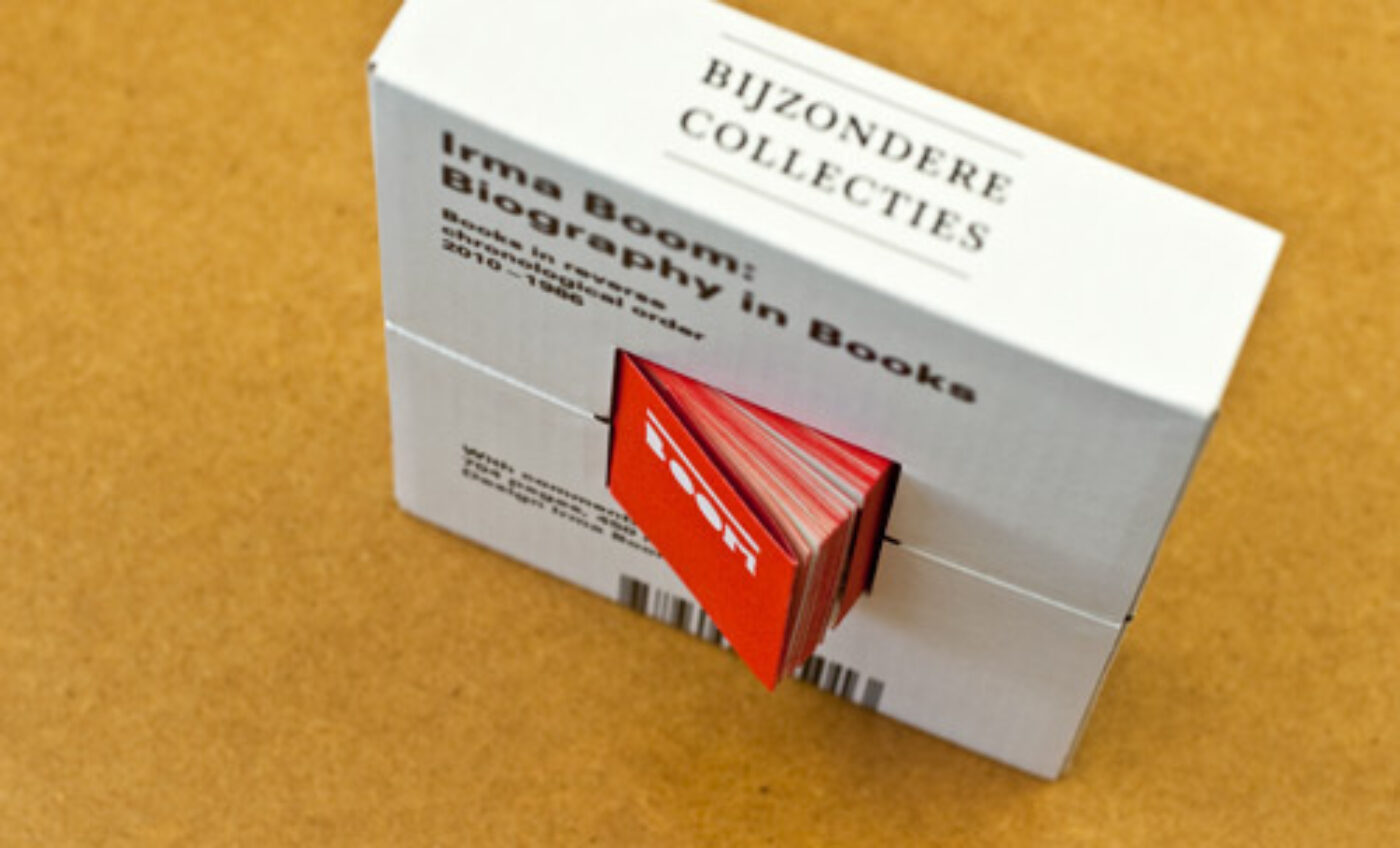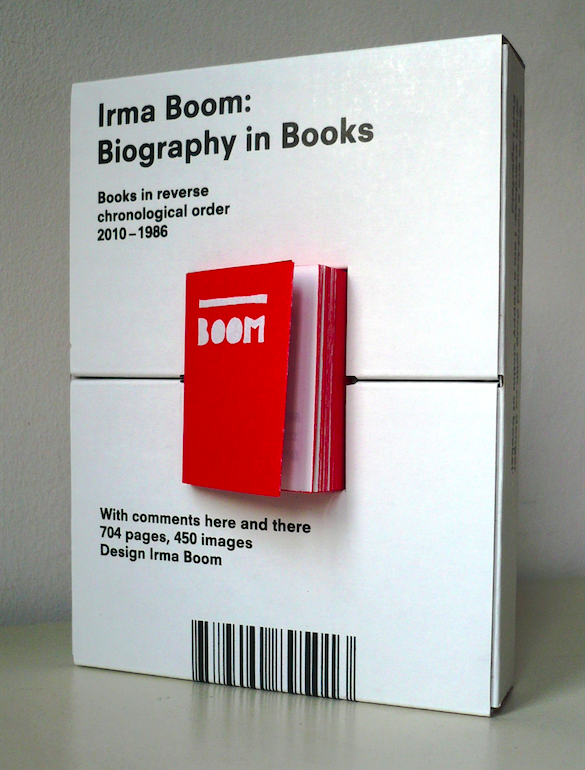
We meet Irma in her recently extended office in Amsterdam South. She’ll use the extra space in part to house a book library she’s been compiling over the years. The collection provides an overview of books and book design over the centuries – an inspiration for her work. But the office space itself is immaculately white and clean. Every project starts with a clean sheet, a literal tabula rasa; her work space exemplifies that.
Arjen Oosterman: You are a book designer. You are always insisting on this fact that you are a book designer, right?
Irma Boom: Yes, because otherwise people think that I am a tunnel designer, or a stamp designer, or a coin designer. But I love to make books. That’s the passion. And that’s the field I want to work in because of the dimensions. You don’t design one page or one flat image, but you design an object; that is important to me. I like to tell stories and in printed matter the book is the ultimate medium to do that, I think. Rem [Koolhaas] always calls me a ‘book-maker’. That it’s the whole idea! It has depth, it has different levels of reading and the fact that the book is a bound object where information is edited and compiled to make a new entity, a new piece to relate to and reflect on. If you compare it to internet where everything is fluxed and everything can change, a book or a magazine or something printed and bound is unchangeable. That’s challenging, I think, and an big opportunity. Even more so now than ever before because of all the digital media. The book becomes more relevant because of that unchangeable entity. It’s different if you place information in a book or on the internet. A book has another aesthetics, another value, and that really interest me.
AO: Book and book design have a long history. But you are a present-day, 21th century designer, so how do those two relate to one another?
IB: Well, it’s really interesting to refer to old books. I am starting a library here upstairs including old books. It’s all after Gutenberg – I like the printed book, not something handwritten. The first printed books were really exiting. In retrospect, they were more experimental than nowadays books. So, in this library I have these old books as reference. Same for the 1960s, that was total freedom, also in book design. Those moments were really the moments where something happened. So for me the old book is really a reference, but I always change it because I think we need to research what a book is. And also to keep the book vital; if we only have books as in the old days that doesn’t work. You need to experiment and find the limits of what a book is.

To accompany a major retrospective exhibition of her work in 2010, Irma Boom produced an exceptional catalogue; this miniature book (38 X 50 mm) contains a complete overview of her work, with commentary and more than 450 full colour illustrations in 704 pages with printed edges. The revised and augmented second edition, published in 2013, has 800 pages and over 500 illustrations.
AO: Now, you work with modern technology, you work from the screen, you work digitally and all that. Does that influence your take on the book?
IB: Yeah it does, but I think I am one of the only book designers who designs books in a book. I make a model first. I want to know how big it is; if it’s large, small, fat, thin, what kind of paper. So I first build the model, that’s why I call it also “the architecture of the book”. So I make a model and when I have the model, of course I have to know what the content is. Sometimes I make the content myself and invite authors, writers, photographers, whatever. So for me, what a book is, is important. If I would start from the screen, I would never have that experience. All these people here [waves at her designer team] work from the screen. I am the one who makes the models and says: “This is a possible book”. The initial design is the thing itself. By doing you get all the ideas. This is the thing, this is it! And I did a lot of inventions because I make books like that.
AO: And is this knowledge, this experience also integrated in your teaching? How do you teach your students to design books?
IB: I am already 24 years teaching at Yale, currently in the role of thesis advisor. Nice about Yale is that everybody is doing anything, but they have to deliver their thesis as a book. Even if they do web design or you name it, they have to make a book. Because the book stays. I remember at the end of the 90s everybody was into web design, animation, and so on, so they were really bored to make a book. But it’s great they still had to do it, because the digital stuff they created back then has become inaccessible by now. And a book is always accessible! I always tell them the story of this major assignment I received in collaboration with a historian. We were asked to make a company jubilee book. We wanted to base it on the notion of internet, a book you can browse through; so, no page numbers, etc. Early 1990s, when the project started, was really the pivotal moment when people got access to the internet. But then we wanted to be modern and young, and I said: oh, let’s do a CD-ROM! So we went to New York to investigate possibilities. But then we realized that by the time we would be ready researching, writing and designing (the project took several years) the technique would be outdated. So we stayed with the idea of a book. Also because one of the client’s request was to make something lasting for the coming 500 years. So its better to make a book, with good paper, good glue. And this is what we did in the end, a really sustainable book.
AO: But how do you get your students started?
IB: At first they’re sitting… “Oh, I don’t know what to do, I don’t know what to do” … Well, if you sit there and don’t do anything, nothing happens! So I encourage them to make. Because they think that making is something crafty, not conceptual. And I tell them that you only can do it with your head, that your hands only work with your head. It’s this combination what makes things happen. If you don’t start making, there is no development. The first talks are always: “…yeah I’m thinking of this and that” … and it is a nice thought, but execute it! Do it! Because if you don’t do it, I don’t believe it! Make it! That’s what architects do, they start immediately making these rough models, they’re not afraid or ashamed to do so. And that is basically what you have to do as a designer. The moment the students start doing, they see progress, and then it becomes also fun. It is not only torture, the project, but it becomes the nice project. And then they say: why didn’t anybody tell us earlier? Well, yeah… I don’t know! [laughs]
AO: And do you also ‘unlearn’ them?
IB: Yes, of course. They are staring at the screen all day and night. I tell them to take a walk. Because the moment you move, your brain works better, the moment you sit it’s really less. It’s true! You have to move. But they sit in their cubicles at school working around the clock; they almost sleep there, specially the Asian people. So the thing is how to get them out and get them to see something. For instance when they’ve discovered (on Google) an interesting detail of a particular book I say: “But this book is in the library, shall we go?” And they say: “Can we go?” Of course! And we go and we have a look together. So that is my thing, to move. I think moving is crucial.
AO: Do you teach them specific skills as well?
IB: Well no, I’m not the one who tells. I tell them how to make the book. But there are other people to help them with their skills. Skills you learn quickly. And also not-knowing all skills is sometimes more interesting than to know how to do it. If I think of myself, how I started… I went to an art school (the AKI in Enschede, the Netherlands) to become a painter and it was chaos, total chaos. In the end I graduated as a graphic designer and my teacher invited me to work for the Government Printing and Publishing house, but I realized I couldn’t do anything. I really didn’t know anything. It made me realize that sometimes not-knowing is a bigger advantage than to know precisely how to do it. You can always recognize if students work in a big office; they know exactly how to do it, totally boring! I think it really more interesting when people try something and maybe produce a brilliant failure, which is much more interesting that all these smooth and slick designs.
AO: So, do you consider (and feel!) yourself a teacher or a student?
IB: Oh, I think that is a very nice question! I feel more a student. Also here in my own studio, I am more a student. The other team members have all the skills, they can touch type, they can do it all. I am the one that is trying other things.
AO: And how does this inform your teaching? Do you teach your students how to learn, do you hand over knowledge, are you ‘shaping’ them to your image?
IB: Some teachers like their students’ work only if it looks like their own work, so they want to create a school. I think what it is interesting, is really the idea that you develop yourself. Self-learning and self-investment, I think that is also important. But you need to be triggered. Some teachers are very good at that.
AO: Are you encouraging your students and are you encouraging yourself to go beyond the sort of natural boundaries of your own profession as ‘book maker’? Because these days you’re doing so many different things: house style, interior design, public space design, wall paper…
IB: …total design! [laughs]. Book design is a very collaborative thing. For me that’s interesting. So if we make Volume we meet you guys (maybe we should meet more!). And if I do an art book for someone in New York then I get to know everything about world art or more than I want to know, I guess. So the things I am doing, because of the collaboration and the subjects, make it already very interdisciplinary. For me it is in the work. And Rem suggested already, in his speech at the launch of my little red book [Irma Boom: Biography in Books] to explore another field. Because I’m always in the same field, I am always with art and architecture. He said: “Why don’t you investigate if you can do something for NASA?” And first I thought: “Ridiculous!” But then I thought: “Maybe it’s not a bad idea actually, maybe I should.”
I think I am ready to make a sort of shift.
* This interview was conducted for and published in the Chinese magazine Manifesto no. 21, published by Shanghai based The Design Republic.